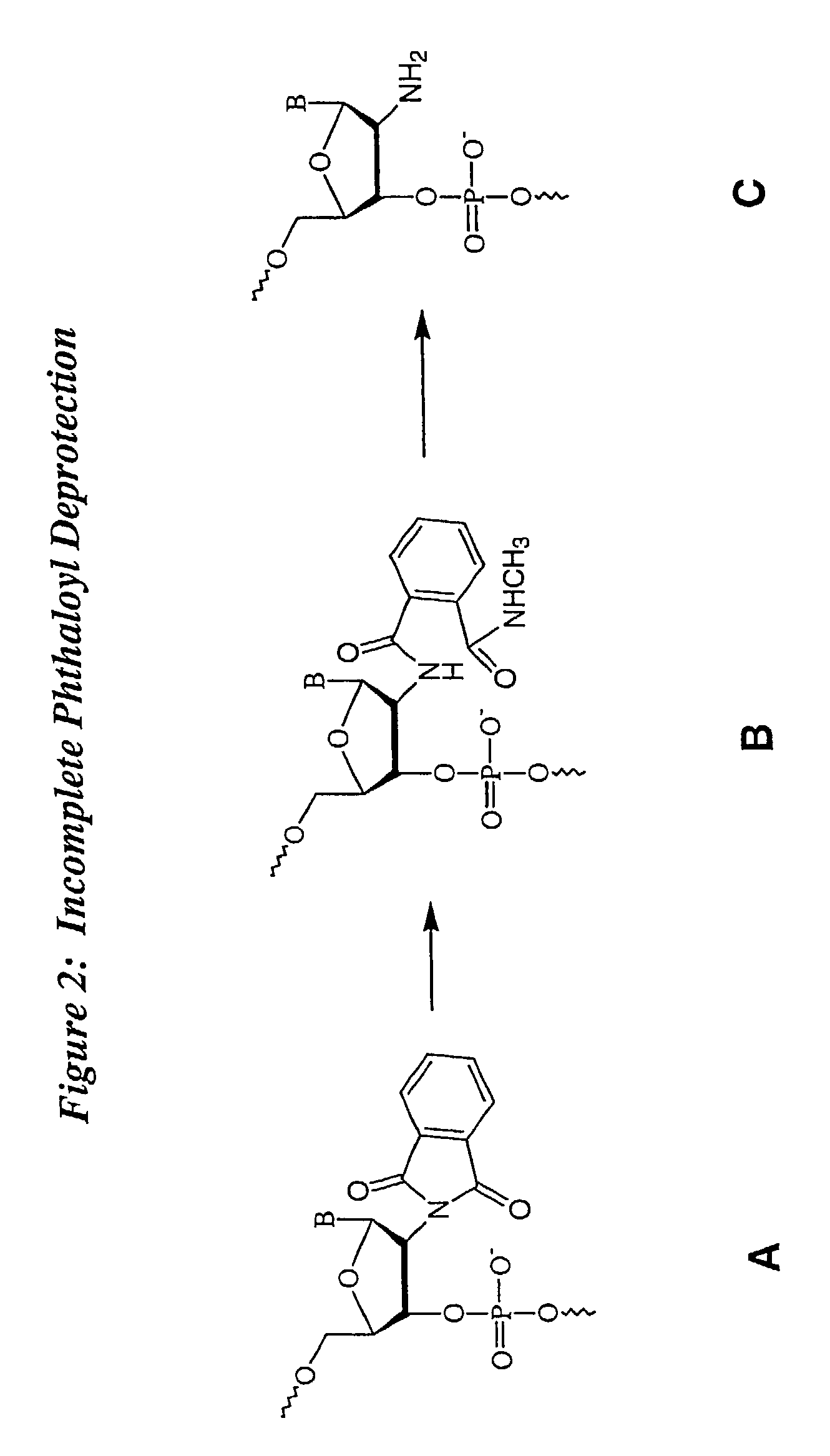Deprotection and purification of oligonucleotides and their derivatives
a technology of oligonucleotides and purification methods, applied in the field of synthesis, deprotection and purification of molecules, can solve the problems of limited deprotection methods for oligonucleotides comprising one or more ribonucleotides, process may require additional optimization in terms of both total deprotection time and resulting oligonucleotide quality, and the “one-pot” anhydrous method is not very effective for
- Summary
- Abstract
- Description
- Claims
- Application Information
AI Technical Summary
Benefits of technology
Problems solved by technology
Method used
Image
Examples
example 1
Small Scale Deprotection of an Oligonucleotide Comprising One or More Ribonucleotides with 2′-O-TBDMS / N-phthaloyl Protection Using a One-Pot Anhydrous Deprotection Method
[0099]A ribozyme sequence (Table III) (200 μmole) containing two N-phthaloyl protected 2′-amino nucleosides was synthesized as described herein, on CPG support with a Pharmacia OPII synthesizer. After the synthesis, the support was dried for 15 to 30 min. Approximately 20 mg of the support was transferred to a 5 ml screw capped vial. A 1:1 mixture of 33% methylamine / ethanol (800 μl) and dry DMSO (800 μl) was added to the support and the mixture was heated at 65° C. using a heating block for 15 min. The solution was cooled to rt and then filtered through a 0.5 micron filter into another 5 ml screw capped vial. TEA.3HF (600 μl) was added to the reaction mixture followed by heating at 65° C. for 15 min. The mixture was then cooled and quenched with 50 mM NaOAc (2 ml). The corresponding deprotected, purified full length...
example 2
Small Scale Deprotection of an Oligonucleotide Comprising One or More Ribonucleotides with 2′-O-TBDMS / N-phthaloyl Protection Using a One-Pot Aqueous Deprotection Method
[0100]A ribozyme sequence (Table III) (200 μmole) was synthesized as described herein on CPG support with a Pharmacia OPII synthesizer. After the synthesis, the support was dried for 15 to 30 min. Approximately 20 mg of the support was transferred to a 5 ml screw capped vial and the support was heated with aqueous methylamine (1 ml) at 65° C. using a heating block for 15 min. The solution was cooled to rt and then filtered through a 0.5 micron filter into another 5 ml screw capped vial. DMSO (1.6 ml) and TEA.3HF (600 μl) were added to the reaction mixture followed by heating at 65° C. for 15 min. The mixture was then cooled and quenched with 50 mM NaOAc (2 ml). The corresponding deprotected, purified full-length oligonucleotide was analyzed by Capillary Gel Electrophoresis and ES Mass Spec. The mass spectrum revealed ...
example 3
Small Scale Deprotection of an Oligonucleotide Comprising One or More Ribonucleotides with 2′-O-TBDMS / N-phthaloyl Protection Using a One-Pot Aqueous Deprotection Method Without DMSO
[0101]A ribozyme sequence (Table III) (200 μmole) was synthesized as described herein on CPG support with a Pharmacia OPII synthesizer. After the synthesis, the support was dried for 15 to 30 min. Approximately 20 mg of the support was transferred to a 5 ml screw capped vial and the support was heated with aqueous methylamine (1 ml) at 65° C. using a heating block for 15 min. The solution was cooled to rt and then filtered through a 0.5 micron filter into another 5 ml screw capped vial. TEA.3HF (600 μl) was added to the reaction mixture followed by heating at 65° C. for 15 min. The mixture was then cooled and quenched with 50 mM NaOAc (2 ml). The corresponding deprotected, purified full-length oligonucleotide was analyzed by ion exchange HPLC. The HPLC trace revealed significant degradation corresponding ...
PUM
| Property | Measurement | Unit |
|---|---|---|
| Temperature | aaaaa | aaaaa |
| Temperature | aaaaa | aaaaa |
| Temperature | aaaaa | aaaaa |
Abstract
Description
Claims
Application Information
 Login to View More
Login to View More - R&D
- Intellectual Property
- Life Sciences
- Materials
- Tech Scout
- Unparalleled Data Quality
- Higher Quality Content
- 60% Fewer Hallucinations
Browse by: Latest US Patents, China's latest patents, Technical Efficacy Thesaurus, Application Domain, Technology Topic, Popular Technical Reports.
© 2025 PatSnap. All rights reserved.Legal|Privacy policy|Modern Slavery Act Transparency Statement|Sitemap|About US| Contact US: help@patsnap.com



